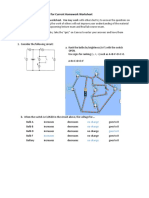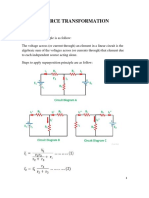Light Bulb II Concept Test: B C B C A A
Light Bulb II Concept Test: B C B C A A
Uploaded by
Md CassimCopyright:
Available Formats
Light Bulb II Concept Test: B C B C A A
Light Bulb II Concept Test: B C B C A A
Uploaded by
Md CassimOriginal Title
Copyright
Available Formats
Share this document
Did you find this document useful?
Is this content inappropriate?
Copyright:
Available Formats
Light Bulb II Concept Test: B C B C A A
Light Bulb II Concept Test: B C B C A A
Uploaded by
Md CassimCopyright:
Available Formats
Light Bulb II
Concept Test
B S
24 V
12 V
C
The light bulbs in the circuit are identical.
When the switch is closed,
1. The intensities of light bulbs B and C
increase.
2. The intensities of light bulbs B and C
decrease.
3. The intensity of light bulb A increases.
4. The intensity of light bulb A decreases.
5. A combination of 1 and 4
6. A combination of 2 and 3
7. Nothing happens
8. None of the above
Light Bulb II
Solution
Lecture S5: Light Bulb II
3
Answer
0 5 10 15 20 25 30 35 40
Number of Students
Lecture S5: Light Bulb II
3
Answer
0 10 20 30 40 50
Number of Students
Before the switch is closed, the current through the three
bulbs must be the same. Thus, the voltage drop across each
bulb is the same. Because the total voltage drop across the
three bulbs is 24 V, the drop across each bulb must be 8 V.
Therefore, if we designate the lower node as ground, the
potential of the node to the left of the switch is 16 V.
After the switch is closed, the potential of the node to the left
of the switch must be 12 V, since the upper terminal of the
battery is 12 V above ground potential. Therefore, the voltage
across bulb A increases, and therefore its intensity increases.
Likewise, the total voltage across bulbs B and C decreases,
and hence there intensities decrease. This is a combination
of #2 and #3, so answer #6 is correct.
By the second try, most students had either answer #2 (which
is partially correct) or #6 (the correct answer). The answer is
a little surprsing — adding a battery in parallel to the lower
bulbs makes them dimmer, not brighter.
Light Bulb III
Concept Test
B S
24 V
12 V
C
The light bulbs in the circuit are identical.
After the switch is closed, the 12 V battery
1. Supplies power to the circuit.
2. Absorbs power.
3. Neither of the above.
Light Bulb III
Solution
Lecture S5: Light Bulb III
1
Answer
0 10 20 30 40
Number of Students
Before the switch is closed, the current through the three
bulbs must be the same. Thus, the voltage drop across each
bulb is the same. Because the total voltage drop across the
three bulbs is 24 V, the drop across each bulb must be 8 V.
Therfore, if we designate the lower node as ground, the
potential of the node to the left of the switch is 16 V.
After the switch is closed, the potential of the node to the left
of the switch must be 12 V, since the upper terminal of the
battery is 12 V above ground potential. Therefore, the voltage
across bulb A increases, and therefore its the current through
it increases. Likewise, the total voltage across bulbs B and C
decreases, and hence the current through them decreases.
So the current through bulb A is greater than the current
through bulb B. To satisfy KCL at the node to the left of the
switch, there most be current to the right through the switch,
and down through the 12 V battery. With current .o wing into
the positive terminal, the current through the battery is
positive (if we are using the passive sign convention), and
therefore the power iv > 0, and hence the battery absorbs
power. The correct answer is #2. In effect, this circuit is a sort
of battery charger, using the 24 V battery to charge the 12 V
battery.
Loop Method
Concept Test
R R
2 e1 4 e2
+
V ia R ib R -I I
_ 3 5
For the network above, .nd the equation that
expresses Kirchhoff’s Voltage Law for the
loop ib . My answer was
1. −R3 ia + (R3 + R4 + R5 )ib = R5 I
2. −R3 ia + (R3 + R4 + R5 )ib = −R5 I
3. −R3 ia + (R3 + R4 )ib = R5 I
4. Not among the answers above
5. I was unable to get an answer
Loop Method
Solution
Lecture S5: Loop Method
2
Answer
0 5 10 15 20 25 30 35 40
Number of Students
The correct answer is Number 2. The voltage drop across R4
(in the ib direction) is R4 ib . The voltage drop across R5 (in
the ib direction) is R5 (ib − (−I)) = R5 (ib + I). The
voltage drop across R3 (in the ib direction) is R3 (ib − ia ).
The total voltage drop around the loop is zero, so
−R3 ia + (R3 + R4 )ib + R5 I = 0
Therefore,
−R3 ia + (R3 + R4 )ib = −R5 I
Many students answered #1. It is a little tricky. To correctly
get the minus sign on the right hand side, you must recognize
that there are three minus signs .oating around — one
because the current in the right hand loop is −I to match the
direction of the current source, one because the loop as
drawn .o ws in the opposite direction as ib through R5 , and
one because the source term has been moved to the right
hand side of the equation.
You might also like
- Freud For BeginnersDocument2 pagesFreud For BeginnersScribdTranslations0% (1)
- The University of Chicago Booth School of BusinessDocument35 pagesThe University of Chicago Booth School of BusinessmrvikeshvamseeNo ratings yet
- 1KB04 - Tugas EldasDocument30 pages1KB04 - Tugas Eldasmaster farhanNo ratings yet
- Chapter 5 Homework SolutionDocument16 pagesChapter 5 Homework SolutionözlemArtuk100% (5)
- Experiment 3 - RL and RC CircuitDocument10 pagesExperiment 3 - RL and RC Circuitnick amir100% (1)
- Chart Patterns ForexDocument16 pagesChart Patterns Forexnishitsardhara83% (6)
- Messerschmitt BF 109 FIGHTER 1935Document114 pagesMesserschmitt BF 109 FIGHTER 1935Mihai Iavorschi100% (3)
- Node Method Concept Test: R 2 R 4 e eDocument5 pagesNode Method Concept Test: R 2 R 4 e eMd CassimNo ratings yet
- 2049 ch27BDocument22 pages2049 ch27BMaherNo ratings yet
- ©university of Colorado, Boulder 2005Document15 pages©university of Colorado, Boulder 2005NeutronNo ratings yet
- First LE: Mar 6 12-2PMDocument27 pagesFirst LE: Mar 6 12-2PMByron BanzonNo ratings yet
- Ac S P InstructorDocument95 pagesAc S P Instructorvschauhan.indiaNo ratings yet
- Jr. Engineer Power Electrical WAPDA 2018Document50 pagesJr. Engineer Power Electrical WAPDA 2018Hamza IzharNo ratings yet
- RC RLDocument4 pagesRC RLShang Divina EbradaNo ratings yet
- Lab-4 ReportDocument8 pagesLab-4 Reportanuraf3thmediaNo ratings yet
- General-Physics-2-Kirchhoff-Law 2Document5 pagesGeneral-Physics-2-Kirchhoff-Law 2carlabiancayuNo ratings yet
- Worksheet (Chapter 26)Document3 pagesWorksheet (Chapter 26)Deta VotNo ratings yet
- Electricity Circuits)Document33 pagesElectricity Circuits)Princess de VeraNo ratings yet
- Physics Exam 4th GradingDocument3 pagesPhysics Exam 4th GradingedwardNo ratings yet
- Solution 07Document6 pagesSolution 07Narendra KumarNo ratings yet
- Lab 1 Introduction Circuit F1Document5 pagesLab 1 Introduction Circuit F1farisizzwan23No ratings yet
- ELECS CompilationDocument74 pagesELECS CompilationRaine LopezNo ratings yet
- Midterm - Fall 2021 - Samar NajjarDocument15 pagesMidterm - Fall 2021 - Samar NajjarZiad KassabNo ratings yet
- Tutorial 2 Cicuit Theorems With AnswerDocument9 pagesTutorial 2 Cicuit Theorems With AnswernisasoberiNo ratings yet
- 8.JEE Main 2019 Jan 12 Afternoon Session Answer Key SolutionDocument26 pages8.JEE Main 2019 Jan 12 Afternoon Session Answer Key Solutiongp1in007No ratings yet
- 10 GR Semiconductor Communication Solution PDFDocument4 pages10 GR Semiconductor Communication Solution PDFHappy SinghNo ratings yet
- Lab 06 - Homework - Conceptual Model For VoltageDocument4 pagesLab 06 - Homework - Conceptual Model For VoltageYashvi SrivastavaNo ratings yet
- 돌프 회로이론 9판 5장 솔루션Document65 pages돌프 회로이론 9판 5장 솔루션냥냥냥No ratings yet
- If The Switch S1 Is Closed and Switch S2 Remains Open, What Lights Will Turn On?Document7 pagesIf The Switch S1 Is Closed and Switch S2 Remains Open, What Lights Will Turn On?Vel Murugan100% (1)
- Circuit & Electronics PDFDocument415 pagesCircuit & Electronics PDFGenesisNo ratings yet
- EE301 Lesson 18 AC Source Transformation and NodalDocument5 pagesEE301 Lesson 18 AC Source Transformation and NodalRajashekhar KNo ratings yet
- TR RL Hukum Ohm Dan Hukum KirchhoffDocument10 pagesTR RL Hukum Ohm Dan Hukum KirchhoffPasmayana Sinaga09No ratings yet
- AEC Experiment 1Document11 pagesAEC Experiment 1khaled saeedNo ratings yet
- 1PUC Electronics Question Papers 2013Document8 pages1PUC Electronics Question Papers 2013Prasad C M100% (3)
- Chapter-Network Theorems.: B.Sc-IDocument28 pagesChapter-Network Theorems.: B.Sc-Iahmad11222No ratings yet
- M31 Knig9404 Ism C31 PDFDocument33 pagesM31 Knig9404 Ism C31 PDFnorma_jeannNo ratings yet
- HK Wah Yan 2023 2nd Term UT 2Document4 pagesHK Wah Yan 2023 2nd Term UT 2Arnold KeNo ratings yet
- GR 12 Term 3 2019 Physical Sciences Resource Pack PDFDocument146 pagesGR 12 Term 3 2019 Physical Sciences Resource Pack PDFKevin SmithNo ratings yet
- Lab 04Document11 pagesLab 04aznia shireenNo ratings yet
- Circuits and Electronics 1Document24 pagesCircuits and Electronics 1Andrei SandulescuNo ratings yet
- ClassnotesMIT - T01 - DC CircuitsDocument8 pagesClassnotesMIT - T01 - DC CircuitsAbhijith KiranNo ratings yet
- Experimental Validation of Superposition TheoremDocument4 pagesExperimental Validation of Superposition TheoremMalik Abdul MajeedNo ratings yet
- Probset 10 SolutionsDocument4 pagesProbset 10 SolutionsJazzverNo ratings yet
- Lab Act 2Document11 pagesLab Act 2Jaymar TrimillosNo ratings yet
- DC Circuits: Homework For TodayDocument47 pagesDC Circuits: Homework For TodayTallDarkElmarNo ratings yet
- DC Circuits: Homework For TodayDocument47 pagesDC Circuits: Homework For TodayMark CrossNo ratings yet
- Learning Activity Worksheet in General Physics 2 Kirchhoff'S Rules I. Introductory ConceptDocument7 pagesLearning Activity Worksheet in General Physics 2 Kirchhoff'S Rules I. Introductory ConceptDino Manuel E. PrestadoNo ratings yet
- CHAPTER 2 DR Wan ZulDocument19 pagesCHAPTER 2 DR Wan Zulnurul najwaNo ratings yet
- Experimental report LC1 THÂN NGỌC SƠN 20195813Document24 pagesExperimental report LC1 THÂN NGỌC SƠN 20195813Hoàng SơnNo ratings yet
- Contoh Soal Hukum Pembagi ArusDocument7 pagesContoh Soal Hukum Pembagi ArusTomi MentariNo ratings yet
- ELE Final MCQDocument141 pagesELE Final MCQSanket KarandeNo ratings yet
- E5Report DalanginDocument13 pagesE5Report DalanginAllen John DalanginNo ratings yet
- Kirchhoff's Laws Lab Pre-Lab Questions PageDocument6 pagesKirchhoff's Laws Lab Pre-Lab Questions PageIqbaalfdlNo ratings yet
- ch31 SolutionsDocument5 pagesch31 SolutionsMegan SenekalNo ratings yet
- Questions On Simple Resistive CircuitsDocument18 pagesQuestions On Simple Resistive Circuitskibrom atsbhaNo ratings yet
- Lab 3 ReportDocument10 pagesLab 3 Reporttahamahmood2903No ratings yet
- Demonstration Project FileDocument19 pagesDemonstration Project FileRohit Hooda80% (5)
- Electrical Energy WorksheetsDocument14 pagesElectrical Energy WorksheetsKrista JacksonNo ratings yet
- Sec1-Network Analysis and Syn (Indiabix)Document20 pagesSec1-Network Analysis and Syn (Indiabix)xaiiNo ratings yet
- Iii. Data and ResultDocument9 pagesIii. Data and ResultHero CourseNo ratings yet
- ECSE 210 Final Review SessionDocument32 pagesECSE 210 Final Review SessionabccdesNo ratings yet
- Physics 8b Midterm 1 Practice TestDocument6 pagesPhysics 8b Midterm 1 Practice TestPooja ParekhNo ratings yet
- Easy(er) Electrical Principles for General Class Ham License (2015-2019)From EverandEasy(er) Electrical Principles for General Class Ham License (2015-2019)Rating: 5 out of 5 stars5/5 (1)
- IPSL Boot Camp Part 5: CDO and NCO: 1 Climate Data OperatorsDocument10 pagesIPSL Boot Camp Part 5: CDO and NCO: 1 Climate Data OperatorsMd CassimNo ratings yet
- A Procedure For The Classification of Synoptic Weather Maps From G R I D D E D Atmospheric Pressure Surface DataDocument14 pagesA Procedure For The Classification of Synoptic Weather Maps From G R I D D E D Atmospheric Pressure Surface DataMd CassimNo ratings yet
- Stepwise Regression: Forward (Step-Up) SelectionDocument7 pagesStepwise Regression: Forward (Step-Up) SelectionMd CassimNo ratings yet
- Advisory & Transaction Services: Corporate Real Estate Team OverviewDocument5 pagesAdvisory & Transaction Services: Corporate Real Estate Team OverviewMd CassimNo ratings yet
- RC Circuit Step Response I: Find The Differential Equation That Describes The Circuit BelowDocument7 pagesRC Circuit Step Response I: Find The Differential Equation That Describes The Circuit BelowMd CassimNo ratings yet
- s05 CgsDocument6 pagess05 CgsMd CassimNo ratings yet
- Lecture S4 Muddiest Points: General CommentsDocument2 pagesLecture S4 Muddiest Points: General CommentsMd CassimNo ratings yet
- Lecture S1 Muddiest Points: General CommentsDocument3 pagesLecture S1 Muddiest Points: General CommentsMd CassimNo ratings yet
- Lecture S3 Muddiest Points: General CommentsDocument3 pagesLecture S3 Muddiest Points: General CommentsMd CassimNo ratings yet
- What Is A Model? Concept TestDocument6 pagesWhat Is A Model? Concept TestMd CassimNo ratings yet
- Battery Model Concept TestDocument2 pagesBattery Model Concept TestMd CassimNo ratings yet
- s01 CgsDocument3 pagess01 CgsMd CassimNo ratings yet
- Superposition I: G U (T) y (T) UDocument7 pagesSuperposition I: G U (T) y (T) UMd CassimNo ratings yet
- Handbook PDFDocument40 pagesHandbook PDFMd CassimNo ratings yet
- Notes On The Control of An Aircraft With Throttle OnlyDocument5 pagesNotes On The Control of An Aircraft With Throttle OnlyMd CassimNo ratings yet
- Equation of MotionDocument61 pagesEquation of MotionMd CassimNo ratings yet
- AD - Landing Field LengthDocument1 pageAD - Landing Field LengthMd CassimNo ratings yet
- Indian Institute of Tropical Meteorology (Iitm), Dr. Homi Bhabha Road, Pashan, Pune-411008Document2 pagesIndian Institute of Tropical Meteorology (Iitm), Dr. Homi Bhabha Road, Pashan, Pune-411008Md CassimNo ratings yet
- Thermodynamic SystemDocument12 pagesThermodynamic SystemLORRAINE ATIENZANo ratings yet
- UID Product Master Report - W14 GTDocument29 pagesUID Product Master Report - W14 GTTho Baqo19No ratings yet
- Gift From Wild-WPS OfficeDocument2 pagesGift From Wild-WPS OfficeJaemyhunNo ratings yet
- MAD Question BankDocument3 pagesMAD Question BankStuti ShahNo ratings yet
- SMK Green Road Term 2 Trial Exam 2019 MSDocument4 pagesSMK Green Road Term 2 Trial Exam 2019 MSvoon sjNo ratings yet
- Anthropometry and Clothing ConstructionDocument9 pagesAnthropometry and Clothing ConstructionAsif MangatNo ratings yet
- t6d Denison Vane Pumps IndustrialDocument5 pagest6d Denison Vane Pumps Industrialisrael ruiz gallardoNo ratings yet
- Iapmo 4197 PDFDocument15 pagesIapmo 4197 PDFIvan FlorezNo ratings yet
- Wa0001.Document3 pagesWa0001.Kavita KapseNo ratings yet
- Vector 2 Notes - by TrockersDocument139 pagesVector 2 Notes - by TrockersFerguson UtseyaNo ratings yet
- Pune Event Mobile NumberDocument3 pagesPune Event Mobile Numbersalespin201No ratings yet
- AnimalKingdom PpsDocument23 pagesAnimalKingdom PpsNada DinićNo ratings yet
- Mahmoud Mohamed Mady Ali: EmailDocument3 pagesMahmoud Mohamed Mady Ali: Emailkhaled ahnedNo ratings yet
- Meen201101036 Lab 02Document53 pagesMeen201101036 Lab 02saimiqbal131No ratings yet
- Naveen Maths ExamDocument5 pagesNaveen Maths ExamvaibhavrajsinghsgNo ratings yet
- Writing 9Document2 pagesWriting 9Вероніка ЛітвинчукNo ratings yet
- The Effects of Essence-Formed Cosmetic Ingredients Containing The GalactomycesDocument8 pagesThe Effects of Essence-Formed Cosmetic Ingredients Containing The GalactomycesLwsynergylab OfficialNo ratings yet
- Madagascar Periwinkle Full MonographDocument3 pagesMadagascar Periwinkle Full MonographAnonymous Kqu1xgNo ratings yet
- Trainee's Record Book SWBLDocument12 pagesTrainee's Record Book SWBLaaronjules100% (2)
- Detection and Localization of Multiple Spoofing Attackers in Wireless Networks FAQ'sDocument2 pagesDetection and Localization of Multiple Spoofing Attackers in Wireless Networks FAQ'sPunith RaajNo ratings yet
- Focus Fault ListDocument1 pageFocus Fault ListJESUS LURITANo ratings yet
- Inventory MGT UltraTech Cement ST Joseph's 2024Document102 pagesInventory MGT UltraTech Cement ST Joseph's 2024ahmedaljeelaniNo ratings yet
- BADM 102 - Chap 03Document12 pagesBADM 102 - Chap 03vanshluthra47No ratings yet
- Rulebook Prison OutbreakDocument48 pagesRulebook Prison OutbreakRick Snider100% (1)
- MarginalismDocument24 pagesMarginalismAryo RahendraNo ratings yet
- Instructions For Authors: Essential Title Page InformationDocument4 pagesInstructions For Authors: Essential Title Page InformationKHUSHBU BHALODIYANo ratings yet











































































































